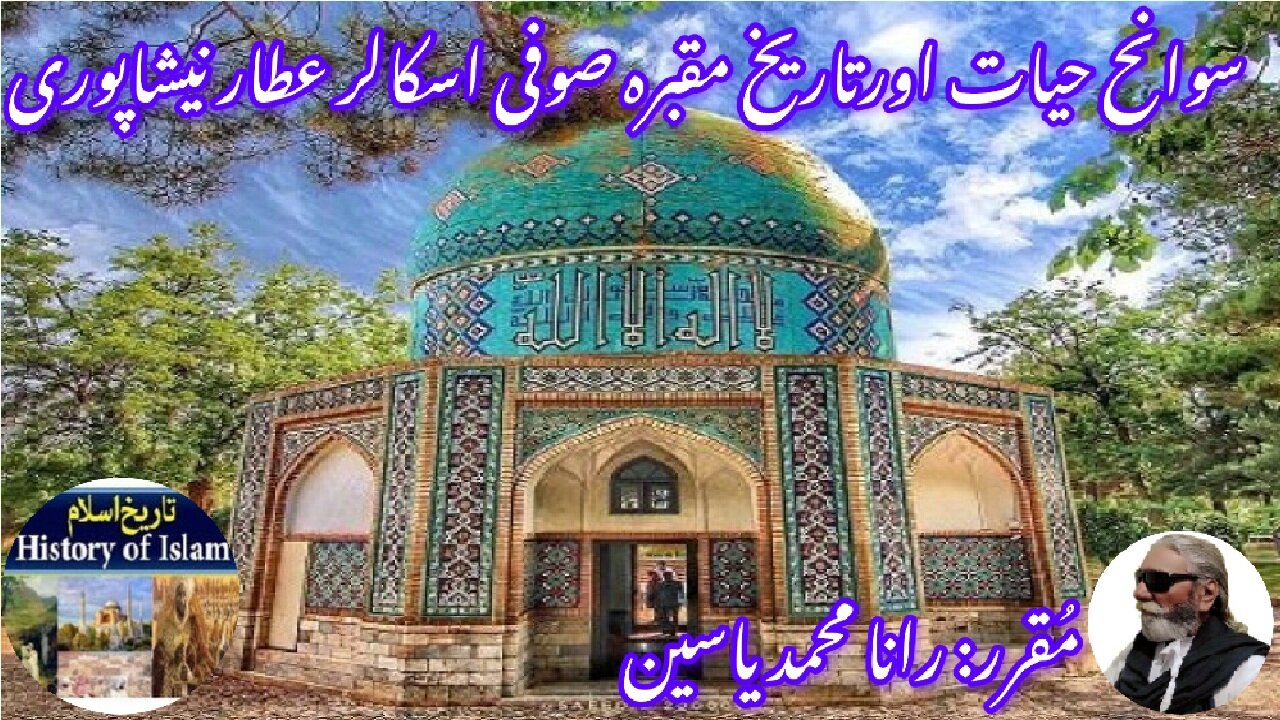Premium Only Content

Biography of Scholar Attar Nishapuri | विद्वान अत्तर निशापुरी | اسکالر عطار نیشاپوری کی سوانح عمری
@islamichistory813 #SufiScholar #AttarLegacy #CulturalHeritage #AttarofNishapur
Biography of Islamic Sufi Scholar Attar of Nishapur
Dekhti Aankhooon aur sountay kaanoon ko Asslamoalaikum, sisters, brothers friends and elders, In this Islamic scholars informative video, we are presenting the biography of Attar of Nishapur, an esteemed Sufi scholar known for his poetic masterpieces and spiritual insights. The narrative not only covers his life and philosophical contributions but also examines the historical context of his shrine in Nishapur, Iran. This sacred site serves as a testament to his enduring impact on Sufism and continues to attract visitors seeking inspiration and reflection. Get to know the rich tapestry of Attar's life and the significance of his memorial in this captivating exploration.
Abu Hamid bin Abu Bakr Ibrahim better known by his pen-names Farid ud-Din and Attar of Nishapur, Attar means apothecary, was an Iranian poet, theoretician of Sufism, and hagiographer from Nishapur who had an immense and lasting influence on Persian poetry and Sufism. He wrote a collection of lyrical poems and number of long poems in the philosophical tradition of Islamic mysticism, as well as a prose work with biographies and sayings of famous Muslim mystics. The Conference of the Birds, The Book of Divine, and Memorial of the Saints are among his best known works.
Information about Attar's life is scarce and has been mythologised over the centuries. However, Attar was born to a Persian family and he practised the profession of pharmacist and personally attended to a very large number of customers. He is mentioned by only two of his contemporaries, `Awfi and Tusi. However, all sources confirm that he was from Nishapur, a major city of medieval Khorasan (now located in the northeast of Iran), and according to `Awfi, he was a poet of the Seljuq period.
According to Reinert: It seems that he was not well known as a poet in his own lifetime, except at his home town, and his greatness as a mystic, a poet, and a master of narrative was not discovered until the 15th century. At the same time, the mystic Persian poet Rumi has mentioned: "Attar was the spirit, Sanai his eyes twain, And in time thereafter, Came we in their train"[8] and mentions in another poem:
Attar was probably the son of a prosperous chemist, receiving an excellent education in various fields. While his works say little else about his life, they tell us that he practised the profession of pharmacy and personally attended to a very large number of customers. The people he helped in the pharmacy used to confide their troubles in Attar and this affected him deeply. Eventually, he abandoned his pharmacy store and travelled widely - to Baghdad, Basra, Kufa, Mecca, Medina, Damascus, Khwarizm, Turkistan, and India, meeting with Sufi Shaykhs - and returned promoting Sufi ideas. Attar was a Sunni Muslim.
From childhood onward Attar, encouraged by his father, was interested in the Sufis and their sayings and way of life, and regarded their saints as his spiritual guides. At the age of 78, Attar died a violent death in the massacre which the Mongols inflicted on Nishapur in April 1221. Today, his mausoleum is located in Nishapur. It was built by Ali-Shir Nava'i in the 16th century and later on underwent a total renovation during the rule of Reza Shah in 1940.
The Diwan of Attar consists almost entirely of poems in the Ghazal ("lyric") form, as he collected his Ruba'i ("quatrains") in a separate work called the Mokhtar-nama. There are also some Qasida ("Odes"), but they amount to less than one-seventh of the Divan. His Qasidas expound upon mystical and ethical themes and moral precepts. They are sometimes modelled after Sanai. The Ghazals often seem from their outward vocabulary just to be love and wine songs with a predilection for libertine imagery, but generally imply spiritual experiences in the familiar symbolic language of classical Islamic Sufism. Attar's lyrics express the same ideas that are elaborated in his epics. His lyric poetry does not significantly differ from that of his narrative poetry, and the same may be said of the rhetoric and imagery.
Attar is one of the most famous mystic poets of Iran. His works were the inspiration of Rumi and many other mystic poets. Attar, along with Sanai were two of the greatest influences on Rumi in his Sufi views. Rumi has mentioned both of them with the highest esteem several times in his poetry. Rumi praises Attar as follows:
Attar has roamed through the seven cities of love while we have barely turned down the first street.
Attar was a pen-name which he took for his occupation. Attar means herbalist, druggist, perfumist or alchemist, and during his lifetime in Persia, much of medicine and drugs were based on herbs. Therefore, by profession he was similar to a modern-day town doctor and pharmacist. Further, 'Attar also refers to rose oil.
Argentine writer Jorge Luis Borges used a summary reference to The Conference of the Birds in his short story, The Approach to Al-Mu'tasim (1936).[26] The Ubuntu Theater Project in Berkeley California premiered an adaptation of Attar's The Conference of the Birds by Sholeh Wolpe, in Oakland, California.
In an 1822 entry, the French writer François-René de Chateaubriand quoted a line, "Palaces are not built on the sea," in Memoirs from Beyond the Grave, 1768-1800. Chateaubriand probably encountered "Farid ud-Din" through the 1819 translation of Silvestre de Sacy, Le Livre des Conseils.
He Died c. 1221 (aged 75–76) The Mausoleum of Attar of Nishapur is located in Nishapur in northeastern Iran. It's located near the Mausoleum of Omar Khayyám. The structure is octagonal in shape with a tile worked onion shaped dome. It has 4 entrances, the northern one is the main entrance. The structure is adorned with colored (green, yellow and blue) tiles and carvings. The interior site is covered by plaster and has four seats. The Mausoleum is located in a garden covering an area of about 119 sq. m. The grave of the well known painter Kamal-ol-molk is also situated in a part of this garden. This mausoleum was initially built by the order of Ali-Shir Nava'i during the reign of the Tmurid dynasty in Persia.
Sisters brothers friends, and elders, now give us permission, up to tomorow, and tomorow we will described Biography of Aurangzeb Alamgir inventor of the Fatawa Alamgiri. Allah Hafiz
=========================
-
 1:39:44
1:39:44
HELMET FIRE
5 hours agoDEADROP IS BACK!
82.6K6 -
 10:03
10:03
Tundra Tactical
7 hours ago $8.50 earnedBrandon Herrera Vies Bid for ATF Director!
45.9K8 -
 22:01
22:01
DeVory Darkins
1 day ago $26.58 earnedHakeem Jeffries SHUTS DOWN The View as Matt Gaetz Speaks out
43.9K95 -
 2:02:54
2:02:54
Mally_Mouse
6 hours agoLet's Play!! - Spicy Saturday
30.1K -
 1:33:06
1:33:06
Slightly Offensive
7 hours ago $20.08 earnedAre You Ready for What's Coming Next? | Just Chatting Chill Stream
48.2K32 -
 32:10
32:10
MYLUNCHBREAK CHANNEL PAGE
1 day agoThe Gate of All Nations
125K54 -
 13:07
13:07
Sideserf Cake Studio
11 hours ago $1.88 earnedIS THIS THE MOST REALISTIC SUSHI CAKE EVER MADE?
46.9K3 -
 21:08
21:08
Clownfish TV
1 day agoElon Musk Tells WotC to BURN IN HELL for Erasing Gary Gygax from DnD!
36.4K13 -
 48:22
48:22
PMG
7 hours ago $6.50 earned"IRS Whistleblowers Speak Out on Biden Family with Mel K In-Studio"
30.1K15 -
 2:59
2:59
BIG NEM
9 hours agoLost in the Wrong Hood: Who Do I Check In With?
24.2K2